Current Trends in Conformal Coating
By Frank Hart, Sales and Marketing Managing Director, PVA
To an equipment manufacturer, conformal coating materials are the essential piece to a customer’s success or failure. The marriage of material and correct application equipment dictates everything from process implementation, line efficiency, quality, and customer satisfaction. This interdependency drives chemical companies and equipment suppliers to a unique relationship. New product or process development is often dictated by the capabilities of each other and developed in tandem.
While performance properties, reworkability, and cure mechanisms all contribute to the marketability of a coating material, ease of application can often dictate how widely a product is accepted by consumers. Further, the technology must exist to process a chemistry per its intended application. This requires equipment manufacturers to work diligently with formulators to assure they have products to meet the demands of material trends throughout the industry.
The Rise of the Equipment-Chemical Relationship
One of the most prominent examples of this chemical equipment supplier relationship occurred nearly 30 years ago as formulators began to heavily market solvent-free, higher viscosity coatings (>100 cps). These materials could not be processed well with non-atomized film coaters, the prevalent technology of the era. The material didn’t flow as well as its lower viscosity alternatives and the coating was applied much too thick as there was no solvent evaporation. This problem quickly turned to opportunity as dispensing companies started to invest in researching atomized application solutions.
The atomized spray valve would subsequently fill this niche while also allowing formulators the opportunity to sell these products to a larger potential market of end users. In the end, equipment manufacturers, chemical formulators, and the customer all benefitted as they were able to access their preferred material and process the chemistry in the most efficient way possible. This type of win-win scenario is very indicative of the relationship shared by equipment fabricators and chemical formulators. Precision atomized spray heads are still widely used today for coatings above 100 cps and virtually all UV coatings.
An Era of Customization
We are now in an era of customization. Chemistries are highly tailored for critical properties such as protection characteristics, adhesion, and viscosity. Two-component coatings can provide more rapid curing times. As formulations continue to get customized for users, the traditional lines for coating materials and industries continue to blur as end users have more options than ever.
No matter what the request may be, from appearance to viscosity, to the cure mechanism or even changing the solvent carrier to a VOC friendly alternative, customizing formulations has become the norm more than the exception and chemical manufacturers are marketing these products as standard solutions. End users should always work with formulators to assure that any modification to the original chemistry does not affect performance properties such as adhesion, protection, or curing.
From an application standpoint, having your chemistry slightly altered may affect a variety of process parameters so always consult your material manufacturer and applications staff prior to making any formulation change. In an automated process, the changes may be as simple as modifying the robot speed or adjusting the path spacing to compensate for the new flow characteristics, but these factors can always be prequalified in a test laboratory.
More often, we are seeing the application options available to end users increase significantly into less flexible, but more process specific solutions. Customization in material properties has led to an equivalent niche market of application heads. The scope of end users’ process parameters has never been more divergent. High mix, low volume users still seek the most flexible solutions whereas high volume manufacturers are sacrificing flexibility in favor of fast, accurate applicators designed specifically for their process.
Other Considerations: Industry, Time, Geography, Regulations
Many coating chemistries generally follow the industry they are serving. For instance, strength in the global automotive industry drives demand for silicone coating products due to their excellent temperature and moisture resistance. Similarly, as aerospace, white goods, and consumer electronics products are coated, you tend to see more UV and moisture cure acrylics and urethanes due to their overall protection properties and ease of reworkability. The industry and subsequent environment that the end product is exposed to absolutely drives trends in formulation demand and equipment design.
Today, many of our customers favor the fast-cure properties of UV chemistries. Our high-volume coating lines are nearly 2:1 in favor of UV cure over heated or moisture cure alternatives. The geography of the application can also greatly influence the coating selection. Regional preferences often drawn from local environmental regulations can sway users to a specific coating type.
While silicones have been favored in automotive electronics, formulation improvements to quick-cure UV chemistries have penetrated this market. Improved adhesion, moisture resistance, and secondary cure mechanisms have led us to see more automotive applications, particularly, EV projects, move to UV materials.
Solvent-based acrylics and urethanes remain very popular in Europe where they have historically dominated this market. In the United States, there are states that have very tight restrictions on solvent or VOC emissions. These regulations drive coaters to more environmentally friendly formulations. Restrictions or simply personal preferences such as these have caused many chemical companies to revisit their formulations over the past decade and introduce more environmentally friendly versions of their coatings to open new markets for their products.

